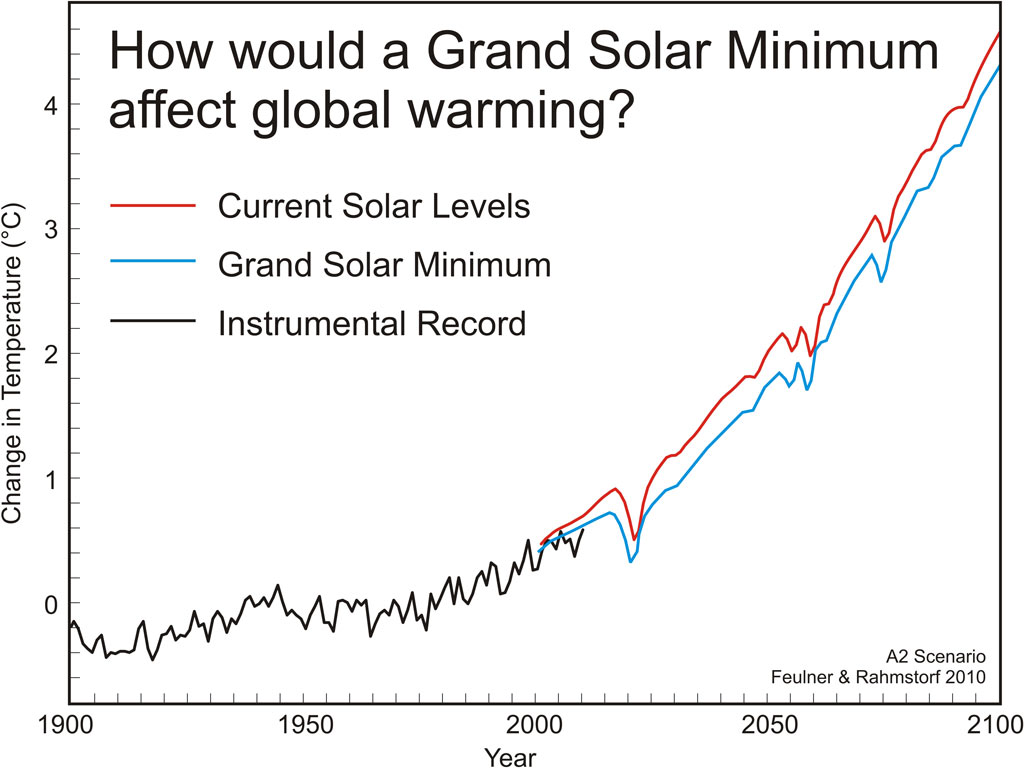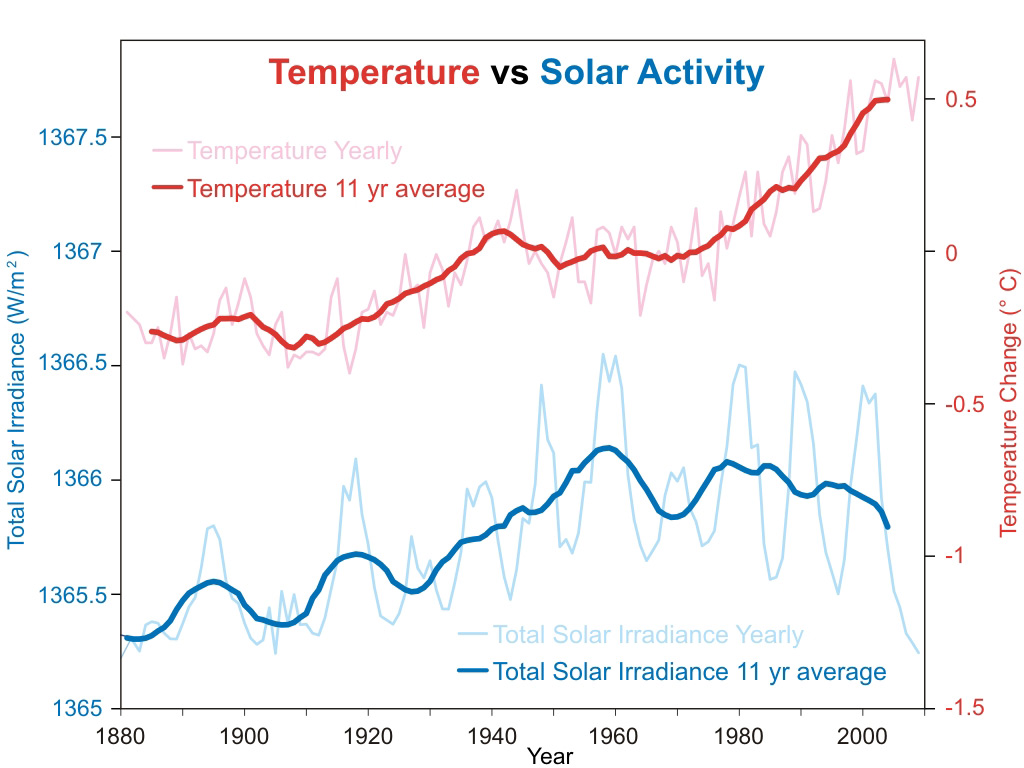No, the sun isn't going to save us from global warming
Posted on 16 July 2015 by dana1981
Some zombie myths just won’t die. In fact, I debunked this one two years ago at The Guardian.
To sum up, a number of scientific studies have asked the question, ‘if the sun were to enter another extended quiet phase (a grand solar minimum), how would that impact global surface temperatures?’. Every study agrees, it would cause no more than 0.3°C cooling, which would only be enough to temporarily offset about a decade’s worth of human-caused global warming.
The global mean temperature difference is shown for the time period 1900 to 2100 for the IPCC A2 emissions scenario. The red line shows predicted temperature change for the current level of solar activity, the blue line shows predicted temperature change for solar activity at the much lower level of the Maunder Minimum, and the black line shows observed temperatures through 2010. Adapted from Feulner & Rahmstorf (2010).
Denial101x lecture debunking the ‘impending mini ice age’ myth by Dana Nuccitelli
Solar activity is actually quite stable. That’s a good thing for us on Earth, because without big swings in the amount of energy reaching the planet from the sun, our climate is likewise generally quite stable. That’s allowed us to build big immobile cities and farms, with the confidence that the climate and weather will be pretty consistent in those areas. It’s allowed human civilization to develop over the past 10,000 years. Though with human-caused global warming in the process of destabilizing the climate, we’re putting that civilization under serious stress.
Back from the dead
Recently there’s been a flood of media stories claiming that the sun may be headed towards a quiet phase (a possibility), which could send the Earth into a “deep freeze” (a virtual impossibility). These stories appear to have originated in the biased conservative media (like the Daily Mailand Telegraph) and seeped into other media outlets (like CNN). Some media outlets, like the Washington Post, did a good job researching the story and discovering its flaws before publishing.
The stories stemmed from a presentation at the Royal Astronomical Society’s National Astronomy Meeting in Wales by mathematician Valentina Zharkova. Her research (not yet published) suggests the sun could be headed for a quiet phase like the one that coincided with a period known as the “Little Ice Age,” but doesn’t say anything about how this solar minimum would impact the Earth’s climate.
Some of the fault for raising this zombie myth from the dead lies with the Royal Astronomical Society’s press release, which mentioned the previous mini ice age without making it clear that it was solar activity but not the Earth’s climate that was the subject of the study. Some of the fault lies with Zharkova, who made comments ‘skeptical’ of human-caused global warming that were not supported by her research.
And much of the fault lies with media oulets like the Daily Mail and Telegraph, which ran rather sensationalist stories about an impending mini ice age apparently without consulting a single climate scientist. It’s not a coincidence that the media outlets that didn’t contact climate scientists spread this myth, while the media outlets that did contact climate scientists debunked it.
An easy myth to debunk
This ‘impending mini ice age’ myth is incredibly easy to debunk. In fact it just takes asking one simple question – if the sun is such a key driver of the Earth’s climate, then why has the entire planet (air, oceans, land, and ice) warmed rapidly over the past 60 years while solar activity has declined?
Annual global surface temperature change (thin light red) with 11 year moving average of temperature (thick dark red). Temperature from NASA GISS. Annual Total Solar Irradiance (thin light blue) with 11 year moving average of TSI (thick dark blue).
That simple question is sufficient on its own to debunk the notion that the sun is the main driver of global temperatures. Research has clearly shown, it’s carbon dioxide that’s the temperature’s main control knob.
Second, research has suggested that the solar minimum around the year 1650 played a relatively small role in the cool temperatures during the Little Ice Age. Instead, heightened volcanic activity (pumping ash into the atmosphere that blocks sunlight) and a drop in atmospheric carbon levels were the main contributors to the cooling during that time.
Third, the Little Ice Age wasn’t even that cold, globally. The following chart shows the most comprehensive global surface temperature reconstruction to date, from the PAGES 2k Consortium. In just the past few decades the planet has warmed more than it cooled during the entire Little Ice Age.

Green dots show the 30-year average of the new PAGES 2k reconstruction. The red curve shows the global mean surface temperature, according HadCRUT4 data from 1850 onwards. In blue is the original hockey stick of Mann, Bradley and Hughes (1999) with its uncertainty range (light blue). Graph by Klaus Bitterman. 400 years of sunspot observations are inlaid, created by Robert Rohde.
There was significant regional cooling during the mini ice age, particularly in parts of Europe and North America, but globally it was indeed quite little.
Fourth, a grand solar minimum would be a temporary phase. Any cooling it caused would only last a few decades until the end of the event, at which point the increase in solar activity would contribute to global warming.































 Arguments
Arguments
































Comments